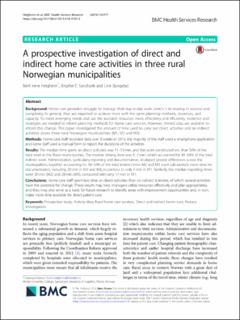| dc.description.abstract | Background: Home care providers struggle to manage their day-to-day work, which is increasing in volume and complexity. In general, they are expected to achieve more with the same planning methods, resources, and capacity. To meet emerging needs and use the available resources more effectively and efficiently, evidence and strategies are needed to inform planning methods for home care services. However, limited data are available to inform this change. This paper investigated the amount of time used to carry out direct activities and six indirect activities across three rural Norwegian municipalities (M1, M2 and M3). Methods: Home care staff recorded data over 8 weeks in 2016; the majority of the staff used a smartphone application and some staff used a manual form to report the durations of the activities. Results: The median time spent on direct activities was 11–13 min, and this work constituted less than 50% of the total work in the three municipalities. The median driving time was 5–7 min, which accounted for 43–54% of the total indirect work. Administration, particularly reporting and documentation, displayed greater differences across the municipalities, together accounting for 38–50% of the total indirect time. M2 and M3 used substantially more time for documentation, including 20 min in M2 and M3, in contrast to only 1 min in M1. Similarly, the median reporting times were 30 min (M2) and 28 min (M3), compared with only 17 min in M1. Conclusions: Home care staff spent less time on direct activities than on indirect activities, of which several activities have the potential for change. These results may help managers utilize resources effectively and plan appropriately, and they may also serve as a basis for future research to identify areas with improvement opportunities and, in turn, make more time available for direct patient care. Keywords: prospective study, activity data, rural home care services, direct and indirect home care, process investigation | en_US |

